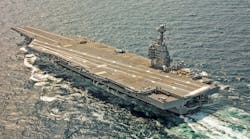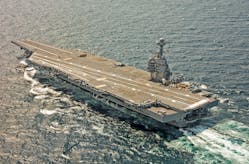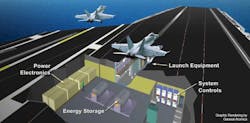The USS Gerald R. Ford, the Navy's newest aircraft carrier, was the first to successfully test launch an aircraft using an electromagnetic launch system (EMALS). The mission and function of EMALS will be similar to the traditional steam catapult, however, it will employ power electronic technologies. After its test phase is completed and EMALS is operational it will expand the capability of the Navy’s future carriers to handle all current and future planned carrier aircraft—from lightweight unmanned aircraft to heavy strike fighters.
The USS Gerald R. Ford is the Navy’s newest nuclear aircraft carrier.
EMALS benefits include:
- Increased reliability and efficiency.
- More accurate end-speed control and smoother acceleration that puts less stress on airframes.
- Expanded operational capability with increased sortie rates.
- Cost reduction over time due to decreased manning and maintenance requirements.
- Ability to launch a broader range of naval aircraft—from lightweight unmanned to heavy strike fighters—with less stress on the ship and aircraft.
- Provides 30% more launch energy capacity, allowing it to handle heavier fighters.
- Compared with steam, it provides substantial improvements in system weight, volume, and maintenance.
- Compared with steam it requires less space and maintenance requirements because it eliminates most of the steam catapult’s piping, pumps, motors, control systems, etc.
- Quieter and cooler work and living spaces for sailors.
- More intuitive maintenance software to reduce troubleshooting times.
- Ability to embed diagnostic systems, for ease of maintenance with fewer personnel on board.
- Reduces the need for energy-intensive desalination employed with steam systems.
Looking Back
For over 60 years, aircraft carriers around the world have launched fixed-wing aircraft using steam catapults, in which a head of live steam blasted a piston down a slot in the flight deck that dragged the airplane along and hurled it into the air. Modern nuclear-powered carriers divert steam from the nuclear-powered turbines to the catapult system that manipulates steam pressure levels and, once high enough, uses the force of steam release to launch airplanes into the air.
Current steam catapults use about 615 kg (1,350 pounds) of steam for each aircraft launch. Adding the required hydraulics and oils, the water required to brake the catapult, and associated pumps, motors, and control systems results in a large, heavy, maintenance-intensive system. This system operates without feedback control and its sudden shocks can shorten lifespans for carrier-based aircraft.
The amount of steam needed to launch an airplane depends on the craft’s weight, and once a launch has begun, adjustments cannot be made. If it uses too much, the nose-wheel landing gear that attaches to the catapult can be ripped off the aircraft. If too little steam is used, the aircraft won’t reach takeoff speed and can tumble into the water.
The launch control system for electromagnetic catapults, on the other hand, will know what speed an aircraft should be at any point during the launch sequence. And, it can make adjustments during the process to ensure that an aircraft will be within 3 mph of the desired takeoff speed.
The EMALS uses a linear induction motor (LIM) to propel a carriage along a track to launch the aircraft. The linear induction motor consists of a row of stator coils with the same function as the circular stator coils in a conventional induction motor. When energized, the motor accelerates the carriage along the track. Only the section of the coils surrounding the carriage is energized at any given time, thereby minimizing reactive losses. The EMALS’ 300-foot (91 m) LIM will accelerate a 100,000-pound (45,000 kg) aircraft to 130 knots (240 km/h,150 mph).
The Electromagnetic Launch System (EMALS), produced by General Atomics Electromagnetic Systems (GA-EMS), is a computer-based power electronics system that controls the launch of carrier-based aircraft.
During a launch, the induction motor requires a large surge of power that exceeds what the ship’s own continuous power source can provide. Therefore, it employs an energy-storage system that draws power from the ship during a 45-second recharge period and stores the energy kinetically using the rotors of four disk alternators. The EMALS then releases that energy (up to 484 MJ) in 2 to 3 seconds. Each rotor delivers up to 121 MJ (34 kWh) from 6,400 rpm (approximately one gasoline gallon equivalent) and can be recharged within 45 seconds of a launch, which is faster than steam catapults. A max launch using 121 MJ from each disk alternator slows the rotors from 6,400 rpm to 5,205 rpm.
During launch, the power conversion subsystem releases the stored energy from the disk alternators using a cycloconverter. This provides a controlled rising frequency and voltage to the LIM, energizing only the small portion of stator coils that affect the launch carriage at any given moment.
Operators control the power through a closed loop system. Hall Effect sensors on the track monitor its operation, allowing the system to ensure that it provides the desired acceleration. The closed loop system allows the EMALS to maintain a constant tow force, which helps reduce launch stresses on an aircraft’s airframe.
One challenge is to scale a relatively new technology to handle the required weights and power. The EMALS motor generator weighs over 80,000 pounds and is 13.5 feet long, almost 11 feet wide, and almost 7 feet tall. It’s designed to deliver up to 60 MJ and 60 MW at its peak. In the three seconds it takes to launch a Navy aircraft, it generates an amount of power that could handle 12,000 homes. This motor generator is part of a suite of equipment called the Energy Storage Subsystem, which includes the motor generator, the generator control tower, and the stored energy exciter power supply. The new USS Gerald R. Ford Class carriers will require 12 of each.
Also undergoing tests on the USS Gerald R. Ford is the Advanced Arresting Gear (AAG). The software-controlled AAG is a modular, integrated system that consists of energy absorbers, power conditioning equipment, and digital controls, with architecture that provides built-in test and diagnostics, resulting in lower maintenance and manpower requirements. AAG is designed to provide higher reliability and safety margins, as well as to allow for the arrestment of a greater range of aircraft and reduce the fatigue impact load to the aircraft.
The AAG sub-program will replace the current Mk 7 hydraulic system used to provide the requisite combination of plane-slowing firmness and necessary flexibility to the carriers’ arresting wires. The AAG design replaces the mechanical hydraulic ram with rotary engines, using energy-absorbing water turbines and a large induction motor to provide fine control of the arresting forces. AAG is intended to allow successful landings with heavier aircraft, reduce manning and maintenance, and adds capabilities like self-diagnosis and maintenance alerts. It will eventually be fitted to all existing Nimitz class aircraft carriers, as well as other members of the new USS Gerald R. Ford class.
Both the EMALS and AAG depend on software that is critical for proper operation. As with most computer-based software, updates and fixes are expected. The Navy has validated a software fix for the EMALS after it was found during testing that the next-generation catapult generates excessive vibration to the aircraft when external fuel tanks are attached. However, final testing involving launches with an instrumented aircraft have been postponed for an additional year, with the service citing competing testing priorities as the reason for the delay. The USS Gerald R. Ford is expected to receive the current software update in 2019, following its Post Shakedown Availability.
The USS Gerald R. Ford (CVN78) is the first new U.S. aircraft carrier design in 40 years as well as the first in its class. The second ship, USS John F. Kennedy (CVN 79) is under construction and work has begun on the future USS Enterprise (CVN 80).


